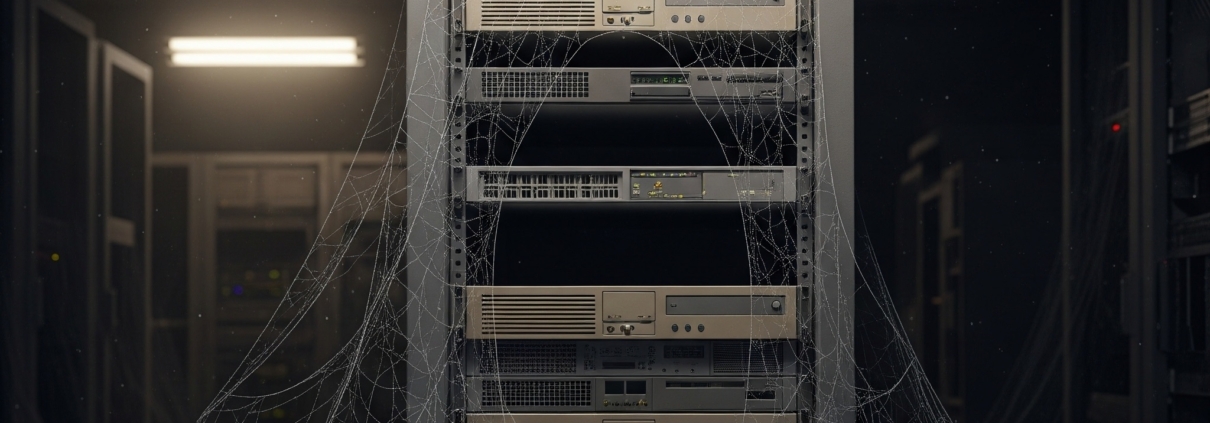The Hidden Threat: Why Decommissioned Hardware Poses Critical Security and Financial Risks
As a licensed security and IT systems integrator serving businesses across New Jersey, Pennsylvania, and Delaware, I’ve conducted countless network assessments for organizations ranging from small manufacturers to large enterprises. During these evaluations, one vulnerability appears with alarming frequency: decommissioned hardware that remains powered and connected to the network.
These “ghost” devices—forgotten servers, switches, access points, and security equipment—represent one of the most overlooked yet dangerous security vulnerabilities in modern business networks. What appears to be harmless old equipment collecting dust is actually a critical liability that can compromise your entire security infrastructure.
The Reality of Forgotten Infrastructure
Decommissioned equipment doesn’t end up on networks through malicious intent. Instead, it’s typically the result of common operational oversights:
Fear of Disruption: IT administrators often hesitate to power down equipment when they’re uncertain about potential dependencies. The concern that shutting down an old server might break an undocumented legacy application keeps these devices running indefinitely.
Absence of Formal Procedures: Many organizations, particularly smaller businesses, lack standardized decommissioning protocols. When migration projects conclude, the old hardware is simply forgotten rather than properly retired.
Resource Prioritization: Decommissioning equipment is frequently viewed as non-critical maintenance, consistently deferred in favor of more pressing operational demands.
Critical Security Vulnerabilities
From a cybersecurity perspective, decommissioned hardware represents an immediate and severe threat to your network security posture.
Unpatched Attack Vectors
Decommissioned devices are, by definition, no longer receiving security updates. This creates multiple attack vectors:
- Operating System Vulnerabilities: Servers running unsupported versions of Windows or Linux contain known, documented security flaws
- Firmware Exploits: Network equipment with outdated firmware provides easy entry points for attackers
- Legacy Security Software: Outdated antivirus and security applications cannot defend against current threats
These vulnerabilities are not theoretical—they represent documented attack vectors that cybercriminals actively exploit. Once an attacker gains access through a compromised legacy device, they can move laterally across your network, potentially accessing sensitive data, deploying ransomware, or compromising critical business systems.
Compliance Violations
For businesses subject to regulatory requirements—including the FTC Safeguards Rule, HIPAA, or PCI DSS—every network-connected device falls within audit scope. Unmanaged, unpatched equipment represents an automatic compliance failure that can result in:
- Substantial financial penalties
- Loss of industry certifications
- Regulatory sanctions
- Reputational damage
The Financial Impact of Ghost Hardware
Beyond security risks, decommissioned equipment creates significant ongoing operational costs.
Direct Power Consumption
A typical legacy server consumes approximately 300 watts continuously, translating to over 2,600 kilowatt-hours annually. At average commercial electricity rates of $0.15 per kWh, each forgotten server costs approximately $400 per year in direct power consumption.
Cooling Infrastructure Strain
Every watt of power consumed generates equivalent heat output. That 300-watt server produces over 1,000 BTUs of heat hourly, forcing your HVAC system to work harder. Commercial cooling typically costs an additional $0.50 to $1.00 for every dollar spent on IT power consumption.
The combined impact means each decommissioned server costs your business $600 to $800 annually—purely for equipment providing zero business value.
Network Performance Degradation
Legacy equipment creates operational inefficiencies:
- Network Loops: Old switches can create routing conflicts
- Bandwidth Consumption: Unnecessary network traffic from unused devices
- Management Complexity: Additional devices complicate network monitoring and troubleshooting
- Interference: Forgotten wireless access points can cause signal interference and confusion
Professional Decommissioning Protocol
Proper hardware decommissioning requires a systematic approach to avoid unintended consequences while ensuring complete security.
Phase 1: Discovery and Assessment
Conduct comprehensive network scanning to identify all connected devices. Cross-reference findings with current asset inventories to identify equipment no longer in active service.
Phase 2: Dependency Analysis
Before powering down any equipment, analyze network traffic logs and system dependencies to ensure the device isn’t supporting critical but undocumented functions.
Phase 3: Data Security
Perform final data backups for servers and save configuration files for network equipment. This ensures compliance with data retention requirements while preserving necessary information for future reference.
Phase 4: Secure Disposal
Execute secure data wiping procedures for storage devices and perform factory resets on network equipment to eliminate any residual configuration data.
Phase 5: Documentation Updates
Update asset management systems, network diagrams, and security documentation to reflect the decommissioned status of removed equipment.
Professional Network Security Assessment
Decommissioned hardware represents just one component of comprehensive network security. As cybersecurity-certified professionals, we understand that effective security requires systematic identification and remediation of all potential vulnerabilities.
If you’re concerned about potential security risks in your network infrastructure, contact Systems Integrations today. Our team can conduct a thorough security assessment and implement professional decommissioning procedures to protect your business from these hidden threats.
Call (866) 417-3787 or contact us at Systems-Integrations.com/contact to schedule your comprehensive network security evaluation.
Systems Integrations provides licensed security integration and IT services throughout New Jersey, Pennsylvania, and Delaware. Our cybersecurity-certified engineers specialize in comprehensive network security assessments and professional infrastructure management.





